| کد مقاله | کد نشریه | سال انتشار | مقاله انگلیسی | نسخه تمام متن |
|---|---|---|---|---|
| 284342 | 509140 | 2016 | 17 صفحه PDF | دانلود رایگان |

• The low cycle fatigue response of bolted T-stub connections to hollow structural section columns is experimentally evaluated
• Typical failure modes and their corresponding hysteretic load-deformation relations are analyzed
• The low cycle fatigue test data are compared with codified design curves incorporating key geometric parameters
• Damage models allowing the deterioration progress of the connections are compared for the behaviour of the connection
Characterization of the low cycle fatigue response of the connection dominated by the hollow structural section (HSS) column in flexural bending and the bolt in tension are necessary to the design of its constitutional semi-rigid joints under earthquake scenarios. This paper presents the results of an experimental programme to evaluate the low cycle fatigue related characteristics of bolted connections to HSS columns. A summary of a total of 69 tension tests of T-stub connections is reported. The geometric parameters were varied as the bolt gauge width, the tube wall slenderness, the bolt size and the tube sidewall depth. Based on the experimental test results, the typical failure mechanisms, the hysteretic load-deformation relation and the response characteristics such as degradations of strength and energy dissipation capacity of the connections are examined. It is shown that the bolt gauge width and the tube wall slenderness have significant influences on the failure mode, the tensile capacity and stiffness which prompt two design parameters; namely, bolt gauge width to tube width ratio (β) and the tube wall thickness-to-half wall width ratio (Ψ0), in quantifying most influential geometric details of the connection. Moreover, the low cyclic fatigue life test results are compared with the codified S–N curves through a transformation of displacement range into effective stress range. It demonstrated a better contrast with test results by further allowing for the geometric parameters of β and Ψ0. Finally, the damage model analysis is employed to study the deterioration progress of the test connections through a comparison with typical damage indices available in the literature. The deficiencies of referred index are identified thereby promoting the proposal of a new model incorporating the stiffness and the energy dissipation in the representation of damage under constant amplitude loading condition. It is shown that the proposed model can give a reasonably well prediction of experimental evidences.
Journal: Journal of Constructional Steel Research - Volume 119, March 2016, Pages 216–232